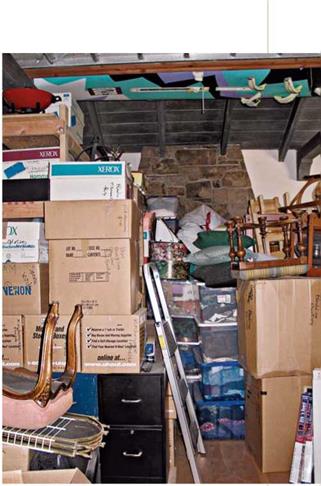GETTING READY FOR DEMOLITION
Living in a house that’s being torn apart and renovated isn’t fun, and it can be murder on marriages. But you can minimize the stress caused by disruption, noise, confusion, and dirt. If you don’t need to be around the house during the demolition, don’t be; that’s a good time to take a vacation. If you just bought the house and can afford the expense of keeping your old place until the demo is done, do so. But if you’re there for the duration, create a clean room—usually a bedroom—in which you do no work at all.
Isolate the zone by covering the doorway with sheet plastic held up by duct tape or by installing temporary plastic walls with zippered doorways such as the Zipwall System®. Situate your Shangri-La upstairs if you can, because dust settles downward. If you are beneath a room being renovated, particularly one in bad repair, tape plastic to the ceiling. In the clean zone, store clothes, stereo equipment, art—anything that
 could get ruined by the omnipresent dirt of tearout. At the end of the day, go there and relax.
could get ruined by the omnipresent dirt of tearout. At the end of the day, go there and relax.
Take care of these items before you start:
► Notify gas, water, and electric companies if you haven’t done so already. Utility representatives can tell you what temporary hookups are safe and who must do them.
► If you’ve newly purchased the building and if inspection reports indicated signs of insect infestation, have a pest-control professional treat the condition before you move in.
► Make sure your general contractor is properly covered by insurance. Or, if you’re acting as your own GC, check with your insurance company to make sure you and any helpers are covered.
► If you don’t have a cell phone, have a telephone installed so you can call for help in an emergency. Have a first-aid kit and fire extinguisher handy. Ensure that everyone on site has had a tetanus shot.
USEFUL TEAR-OUT TOOLS AND EQUIPMENT
Many of the tools mentioned here are shown and discussed at greater length in Chapter 3.
Safety. Be sure you have a voltage tester, hard hat, goggles or safety glasses, a respirator mask with changeable filters, sturdy work gloves, a droplight, and shoes with thick soles.
Dismantling. Your kit should include wrecking bars of various sizes (see the photo on p. 44), a flat utility bar, cat’s paw, hand sledge, full-size sledgehammer, and heavy scrapers. If you’re tearing out masonry, rent an impact hammer with carbide-tipped bits.
Work aids. Rent scaffolding if you’re doing a lot of tearout over your head. Have a good supply of rolls of sheet plastic, duct tape, and heavy tarps; heavy cardboard, Masonite or!8-in. doorskin plywood can be used to protect finish floors. Gather heavy rubber trash cans (they work better than metal ones), wheelbarrows, push brooms, dustpans, square-nose shovels for scooping debris, stepladders, and planks. Rent a Dumpster for big jobs.
![]()
![]()
 Cutting. Wear goggles when cutting out materials, for you’re likely to hit nails. Most blade makers sell demo blades, which are often carbide tipped and frequently thicker than standard blades. Reciprocating saws with demolition blades are the workhorses of renovation. Such blades typically have pointed ends that enable plunge-
Cutting. Wear goggles when cutting out materials, for you’re likely to hit nails. Most blade makers sell demo blades, which are often carbide tipped and frequently thicker than standard blades. Reciprocating saws with demolition blades are the workhorses of renovation. Such blades typically have pointed ends that enable plunge-
you know is hot, to be sure the tester is working correctly. To double-check a receptacle or to check a switch, however, you’ll need to remove the cover plate. To do so safely, follow the procedures described in Chapter 11.
Junction boxes. о As you break open drywall or plaster or pull up flooring, you may find junction boxes. To get at the wires, remove the junction box cover. The wires inside will either be spliced together with wire nuts or be tape wrapped. Using pliers with insulated handles, carefully pull wire groups out of the box and remove wire nuts or tape to expose wire ends. (If you are at all uneasy about handling wires, turn off all the electricity in the house and remove the wire nuts before proceeding.) Touch your voltage tester to the black and white wires simultaneously, then to each wire group and the metal box.
There are also pen-like voltage detectors that can detect electrical current through a wire’s insulation. You simply place the tester sensor near the wire.
Hidden wires. (^) If you unexpectedly discover cables hidden in a wall you are demolishing, stop and turn off all power in the house. Then snip the cable in two with a pair of insulated wire cutters, but never do this when the power is on. After testing both ends of the snipped cable with a voltage
|
A roof-stripping shovel’s serrated edges punch through and pry off drywall plaster lath easily. Wear goggles for this job, and disconnect the electricity before you begin. |
tester to make sure that there is no live current, separate the black and white wires, and wrap the individual wires with electrical tape or cap them with wire nuts. While the power is off, also pull any staples holding the cable to the studs so that you can remove the studs later without damaging the cable.
With the cable thus severed and protected, you may proceed with the demolition. If the cable is to be discarded, disconnect it from the entrance panel. If the cable is to be reconnected, reroute it after the structural work is complete— and house all new connections in a junction box. Again, consult Chapter 11 for further details.








Leave a reply